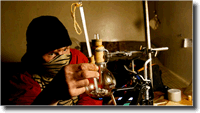About Meth
- What is Meth
- Effects of Meth
- Meth Users
- Signs of Meth use
- Meth Addiction
- Meth Withdrawal
- Meth Overdose
- Meth Addiction Treatment
- Facts About Meth
- Meth Statistics
- Meth Labs
- Meth Ingredients
- Crystal Meth
- Cost of Meth
- Meth Side Effects
- Smoking Meth
- Injecting Meth
- Snorting Meth
- What Does Meth Smell Like
- What Does Meth Look Like
- Meth Mouth
- Meth Sores
- Meth Pictures
- Meth User Pictures

Meth Labs
 How do I recognize meth labs?
How do I recognize meth labs?
Many people may be unaware that they're living near a meth lab. Here are some things to look for:
- Unusual, strong odors (like cat urine, ether, ammonia, acetone or other chemicals).
- Residences with windows blacked out.
- Open windows vented with fans during the winter.
- Renters who pay their landlords in cash. (Most drug dealers trade exclusively in cash.)
- Lots of traffic - people coming and going at unusual times. There may be little traffic during the day, but at night the activity increases dramatically.
- Excessive trash including large amounts of items such as: antifreeze containers, lantern fuel cans, red chemically stained coffee filters, drain cleaner and duct tape. Additionally, many of the chemicals can be found in common household items such as lantern fuel, cleaners, acetone, muriatic acid, and diet pills.
- Unusual amounts of clear glass containers being brought into the home.
- Weapons are very common in meth labs. People who use meth are very paranoid about everything. They are worried that they will be caught by law enforcement and will use any means to not get caught.
Meth labs have many different methods for producing methamphetamine. Each method has its own inherent dangers. Many of the chemicals used are caustic or corrosive, and some of the processes create noxious and harmful fumes.
- If you suspect a meth lab, leave at once and report it.
- Do not open any coolers.
- Do not touch any items. Handling methamphetamine waste residue can burn your skin and eyes, and breathing in the gases can send you to the hospital. Handling these chemicals with unprotected skin, or getting the dust in your eyes can cause serious damage.
- To avoid the possibility of fire, explosion, death or serious illness, only trained and properly equipped workers can dismantle a lab and take the remnants away for disposal, usually in sealed 55-gallon drums.
Presence of the following items could indicate the existence of a meth lab:
- Alcohol
- Ether
- Benzene
- Toluene/Paint Thinner
- Freon
- Acetone
- Chloroform
- Camp Stove Fuel/Coleman Fuel Starting Fluid
- Anhydrous Ammonia
- "Heet"
- White Gasoline
- Phenyl-2-Propane
- Phenylacetone
- Phenylpropanolamine
- Iodine Crystals Red Phosphorous
- Black Iodine
- Lye (Red Devil Lye)
- Drano
- Muriatic/Hydrochloric Acid
- Battery Acid/Sulfuric Acid
- Epsom Salts
- Batteries/Lithium
- Sodium Metal
- Wooden Matches
- Propane Cylinders
- Diet Aids Hot Plates
- Ephedrine (over-the-counter)
- Cold Tablets Bronchodialators
- Energy Boosters
- Rock Salt
Instances of methamphetamine trafficking and abuse in the United States are on the increase. As a result, this drug is having a devastating impact on communities across the nation. Clandestine production accounts for nearly all of the methamphetamine trafficked and abused in the United States. Domestic methamphetamine production, trafficking, and abuse are concentrated in the western, southwestern, and Midwestern United States. Methamphetamine is also increasingly available in portions of the South and eastern United States, especially Georgia and Florida. Clandestine meth labs in California and Mexico are the primary sources of supply for methamphetamine available in the United States.
What are clandestine meth labs?
Clandestine meth labs are laboratories used for the primary purpose of illicitly (illegally) manufacturing controlled substances, such as cocaine and methamphetamine. Clandestine meth labs are typically small, utilizing common household appliances, glassware, and readily available chemicals. Methamphetamine is clandestinely manufactured using the ephedrine or pseudoephedrine reduction method. In this process, over-the-counter cold and allergy tablets containing ephedrine or pseudoephedrine are placed in a solution of water, alcohol, or other solvent for several hours until the ephedrine or pseudoephedrine separates from the tablet. Then, using common household products and equipment listed on the following page and a recipe learned from friends or taken off the Internet, the ephedrine or pseudoephedrine is converted into high quality methamphetamine in makeshift, illegal labs by untrained individuals.
While some clandestine laboratories may be located in industrial areas, they are most frequently located in residential areas. Most clandestine meth labs are located in remote areas where chemical fumes will not alert neighbors or law enforcement. Small-scale meth labs are being operated increasingly in single and multifamily residences in urban and suburban neighborhoods, where they pose a significant threat to public health and safety. Traditionally, meth labs are located in sparsely populated or isolated rural areas in order to avoid detection. A substantial number of laboratories, however, are located in urban areas. If you suspect a meth lab in your neighborhood, do not go into the lab. Many times, people booby trap them to destroy the lab or cover their involvement. Only trained personnel should go into meth labs.
